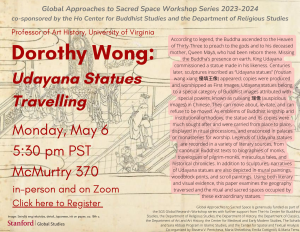 Global Approaches to Sacred Space Workshop Series 2023-2024 co-sponsored by the Ho Center for Buddhist Studies and the Department of Religious Studies, Stanford University
Global Approaches to Sacred Space Workshop Series 2023-2024 co-sponsored by the Ho Center for Buddhist Studies and the Department of Religious Studies, Stanford University
According to legend, the Buddha ascended to the Heaven of Thirty-Three to preach to the gods and to his deceased mother, Queen Māyā, who had been reborn there. Missing the Buddha’s presence on earth, King Udayana commissioned a statue made in his likeness. Centuries later, sculptures inscribed as “Udayana statues” (Youtian wang xiang 優填王像) appeared; copies were produced and worshipped as First Images. Udayana statues belong to a special category of Buddhist images attributed with special powers, known as ruixiang 瑞像 (auspicious images) in Chinese. They can move about, levitate, and can refuse to be moved. As emblems of Buddhist kingship and institutional orthodoxy, the statue and its copies were much sought after and were carried from place to place, displayed in ritual processions, and ensconced in palaces or monasteries for worship. Legends of Udayana statues are recorded in a variety of literary sources, from canonical Buddhist texts to biographies of monks, travelogues of pilgrim-monks, miraculous tales, and historical chronicles. In addition to sculptures, narratives of Udayana statues are also depicted in mural paintings, woodblock prints, and scroll paintings. Using both literary and visual evidence, this paper examines the geography traversed and the ritual and sacred spaces occupied by these extraordinary statues.
